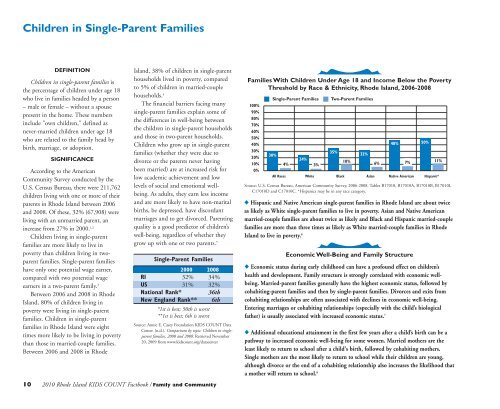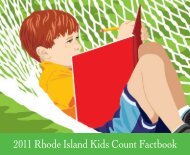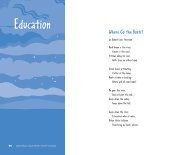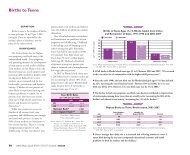2010 Rhode Island Kids Count Factbook
2010 Rhode Island Kids Count Factbook
2010 Rhode Island Kids Count Factbook
Create successful ePaper yourself
Turn your PDF publications into a flip-book with our unique Google optimized e-Paper software.
Children in Single-Parent Families<br />
DEFINITION<br />
Children in single-parent families is<br />
the percentage of children under age 18<br />
who live in families headed by a person<br />
– male or female – without a spouse<br />
present in the home. These numbers<br />
include "own children," defined as<br />
never-married children under age 18<br />
who are related to the family head by<br />
birth, marriage, or adoption.<br />
SIGNIFICANCE<br />
According to the American<br />
Community Survey conducted by the<br />
U.S. Census Bureau, there were 211,762<br />
children living with one or more of their<br />
parents in <strong>Rhode</strong> <strong>Island</strong> between 2006<br />
and 2008. Of these, 32% (67,908) were<br />
living with an unmarried parent, an<br />
increase from 27% in 2000. 1,2<br />
Children living in single-parent<br />
families are more likely to live in<br />
poverty than children living in twoparent<br />
families. Single-parent families<br />
have only one potential wage earner,<br />
compared with two potential wage<br />
earners in a two-parent family. 3<br />
Between 2006 and 2008 in <strong>Rhode</strong><br />
<strong>Island</strong>, 80% of children living in<br />
poverty were living in single-parent<br />
families. Children in single-parent<br />
families in <strong>Rhode</strong> <strong>Island</strong> were eight<br />
times more likely to be living in poverty<br />
than those in married-couple families.<br />
Between 2006 and 2008 in <strong>Rhode</strong><br />
<strong>Island</strong>, 38% of children in single-parent<br />
households lived in poverty, compared<br />
to 5% of children in married-couple<br />
households. 4<br />
The financial barriers facing many<br />
single-parent families explain some of<br />
the differences in well-being between<br />
the children in single-parent households<br />
and those in two-parent households.<br />
Children who grow up in single-parent<br />
families (whether they were due to<br />
divorce or the parents never having<br />
been married) are at increased risk for<br />
low academic achievement and low<br />
levels of social and emotional wellbeing.<br />
As adults, they earn less income<br />
and are more likely to have non-marital<br />
births, be depressed, have discordant<br />
marriages and to get divorced. Parenting<br />
quality is a good predictor of children’s<br />
well-being, regardless of whether they<br />
grow up with one or two parents. 5<br />
Single-Parent Families<br />
2000 2008<br />
RI 32% 34%<br />
US 31% 32%<br />
National Rank* 36th<br />
New England Rank** 6th<br />
*1st is best; 50th is worst<br />
**1st is best; 6th is worst<br />
Source: Annie E. Casey Foundation KIDS COUNT Data<br />
Center. (n.d.). Comparisons by topic: Children in singleparent<br />
families, 2000 and 2008. Retrieved November<br />
20, 2009 from www.kidscount.org/datacenter<br />
Families With Children Under Age 18 and Income Below the Poverty<br />
Threshold by Race & Ethnicity, <strong>Rhode</strong> <strong>Island</strong>, 2006-2008<br />
100%<br />
90%<br />
80%<br />
70%<br />
60%<br />
50%<br />
40%<br />
30%<br />
20%<br />
10%<br />
0%<br />
Source: U.S. Census Bureau, American Community Survey, 2006-2008. Tables B17010, B17010A, B17010B, B17010I,<br />
C17010D and C17010C. *Hispanics may be in any race category.<br />
100<br />
◆ Hispanic and Native American single-parent families in <strong>Rhode</strong> <strong>Island</strong> are about twice<br />
90<br />
as likely 80 as White single-parent families to live in poverty. Asian and Native American<br />
married-couple 70 families are about twice as likely and Black and Hispanic married-couple<br />
families<br />
60<br />
are more than three times as likely as White married-couple families in <strong>Rhode</strong><br />
50<br />
<strong>Island</strong> to live in poverty. 6<br />
40<br />
30<br />
20<br />
10<br />
0<br />
Single-Parent Families<br />
30%<br />
All Races<br />
24%<br />
4% 3%<br />
White<br />
Two-Parent Families<br />
35%<br />
Black<br />
10%<br />
Economic Well-Being and Family Structure<br />
Hispanic*<br />
◆ Economic status during early childhood can have a profound effect on children’s<br />
health and development. Family structure is strongly correlated with economic wellbeing.<br />
Married-parent families generally have the highest economic status, followed by<br />
cohabiting-parent families and then by single-parent families. Divorces and exits from<br />
cohabiting relationships are often associated with declines in economic well-being.<br />
Entering marriages or cohabiting relationships (especially with the child’s biological<br />
father) is usually associated with increased economic status. 7<br />
◆ Additional educational attainment in the first few years after a child’s birth can be a<br />
pathway to increased economic well-being for some women. Married mothers are the<br />
least likely to return to school after a child's birth, followed by cohabiting mothers.<br />
Single mothers are the most likely to return to school while their children are young,<br />
although divorce or the end of a cohabiting relationship also increases the likelihood that<br />
a mother will return to school. 8<br />
32%<br />
Asian<br />
48%<br />
6% 7%<br />
Native American<br />
50%<br />
11%<br />
10 <strong>2010</strong> <strong>Rhode</strong> <strong>Island</strong> KIDS COUNT <strong>Factbook</strong> / Family and Community






